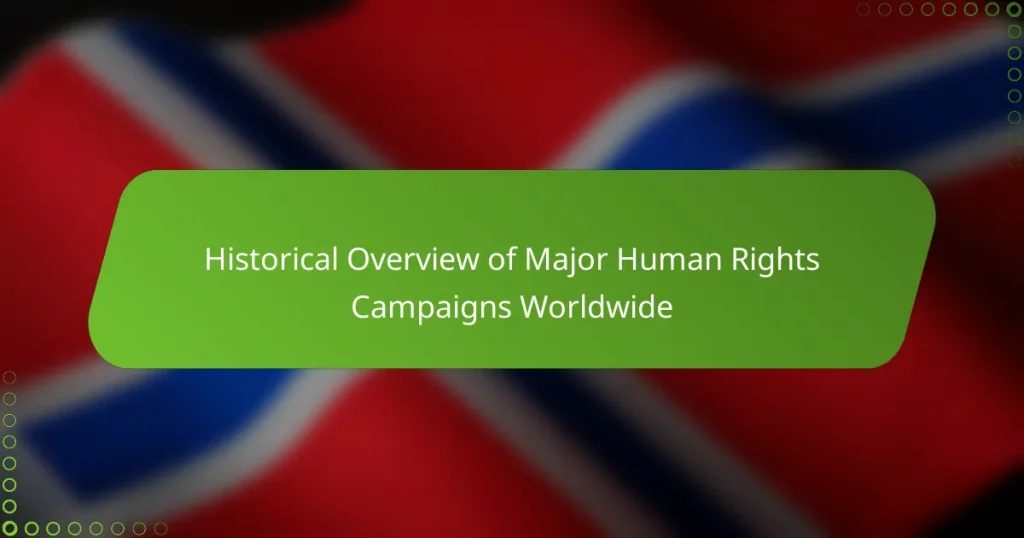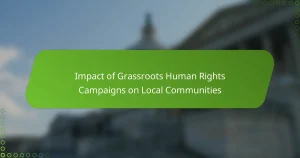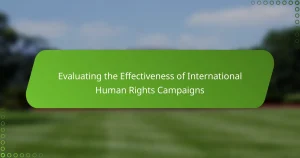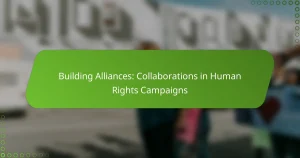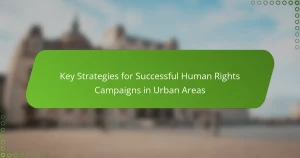The article provides a historical overview of major human rights campaigns worldwide, highlighting significant movements such as the Civil Rights Movement, the Anti-Apartheid Movement, and the Women’s Rights Movement. It outlines the objectives and achievements of these campaigns, detailing how they aimed to end racial segregation, promote gender equality, and combat discrimination based on sexual orientation and gender identity. Key milestones include the Civil Rights Act of 1964, the election of Nelson Mandela in 1994, and the passage of the 19th Amendment in the United States. The article also addresses the importance of grassroots organizing, public demonstrations, and international support in advancing human rights legislation and social norms.
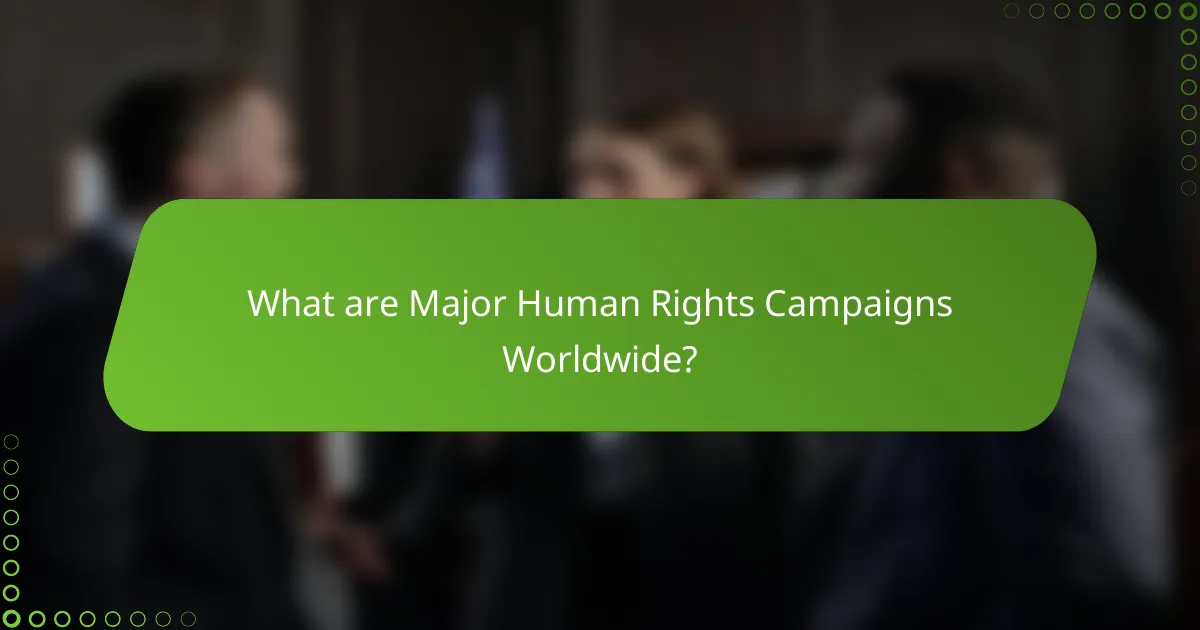
What are Major Human Rights Campaigns Worldwide?
Major human rights campaigns worldwide include the Civil Rights Movement, the Anti-Apartheid Movement, and the Women’s Rights Movement. The Civil Rights Movement in the United States aimed to end racial segregation and discrimination against African Americans. It peaked in the 1960s and led to significant legislative changes, including the Civil Rights Act of 1964.
The Anti-Apartheid Movement focused on ending racial segregation in South Africa. It gained international support and culminated in the release of Nelson Mandela in 1990 and the establishment of a democratic government in 1994.
The Women’s Rights Movement advocates for gender equality and has roots in the suffrage movement of the early 20th century. It has led to legal reforms such as the right to vote and protections against gender-based violence.
Other notable campaigns include [censured] rights movements, which seek to end discrimination based on [censured] orientation and gender identity. These movements have achieved significant milestones, such as the legalization of same-[censured] marriage in various countries.
Each of these campaigns has played a crucial role in shaping human rights legislation and social norms globally.
How have these campaigns evolved over time?
Human rights campaigns have evolved significantly over time. Initially, these campaigns focused on basic civil liberties and the abolition of slavery. In the 20th century, movements expanded to include women’s rights and racial equality.
The 1960s saw a surge in activism, with campaigns addressing issues like segregation and colonialism. The late 20th century introduced a global perspective, emphasizing international human rights standards.
Technological advancements have transformed campaign strategies. Social media has enabled grassroots mobilization and awareness on a larger scale.
Today, campaigns address a wide range of issues, including climate justice and [censured] rights. The evolution reflects changing societal values and the interconnectedness of global communities.
What historical events sparked the inception of major human rights campaigns?
The abolition of slavery in the 19th century sparked major human rights campaigns. This movement aimed to end the inhumane practice of enslaving individuals. The efforts of activists like Frederick Douglass and William Wilberforce were pivotal. The 1948 Universal Declaration of Human Rights was also significant. It established a global standard for human rights. The Civil Rights Movement in the United States during the 1960s further galvanized human rights advocacy. Key figures like Martin Luther King Jr. played a crucial role. The anti-apartheid movement in South Africa, led by Nelson Mandela, was another major event. These historical milestones laid the groundwork for ongoing human rights campaigns worldwide.
How have societal attitudes towards human rights changed throughout history?
Societal attitudes towards human rights have evolved significantly over time. In ancient civilizations, rights were often limited to specific groups, such as nobility or citizens. The Magna Carta in 1215 marked an early shift, establishing the principle that everyone is subject to the law. The Enlightenment in the 18th century further advanced human rights ideas, emphasizing individual liberty and equality. The aftermath of World War II led to the Universal Declaration of Human Rights in 1948, which recognized the inherent dignity of all individuals. Movements for civil rights, gender equality, and [censured] rights in the 20th century reflected growing awareness and advocacy for universal human rights. Today, many societies increasingly recognize the importance of protecting human rights for all individuals, although challenges remain in various regions.
Why are these campaigns significant in global history?
Human rights campaigns are significant in global history because they have driven social change and policy reform. These campaigns have raised awareness about injustices and mobilized public opinion. They have led to the establishment of international human rights laws and treaties. For example, the Universal Declaration of Human Rights was adopted in 1948, setting a global standard for human rights. Additionally, movements like the Civil Rights Movement in the United States have inspired similar efforts worldwide. These campaigns have empowered marginalized groups and fostered greater equality. They have also highlighted the importance of civic engagement and activism in shaping societies. Overall, human rights campaigns have played a crucial role in promoting justice and dignity for all individuals.
What impact have these campaigns had on legislation and policy?
Major human rights campaigns have significantly influenced legislation and policy. These campaigns often highlight injustices and mobilize public opinion. For instance, the Civil Rights Movement in the United States led to the Civil Rights Act of 1964. This act prohibited discrimination based on race, color, religion, [censured], or national origin. Similarly, the Women’s Suffrage Movement resulted in women gaining the right to vote in many countries. Legislative changes often follow widespread activism and advocacy. Campaigns raise awareness and push for legal reforms. They can also lead to the establishment of new policies aimed at protecting human rights.
How have these campaigns influenced public perception of human rights?
Human rights campaigns have significantly shaped public perception of human rights. These campaigns raise awareness about injustices and mobilize support for marginalized groups. For example, the Civil Rights Movement in the 1960s highlighted racial discrimination in the United States. This movement led to the passage of the Civil Rights Act of 1964, which aimed to eliminate segregation. Similarly, the global #MeToo movement has brought attention to [censured] harassment and assault. It has encouraged victims to speak out and seek justice. Surveys show increased public support for gender equality as a result. Campaigns like these have fostered a greater understanding of human rights issues. They have also pressured governments to implement reforms. Overall, these campaigns play a crucial role in transforming societal attitudes toward human rights.
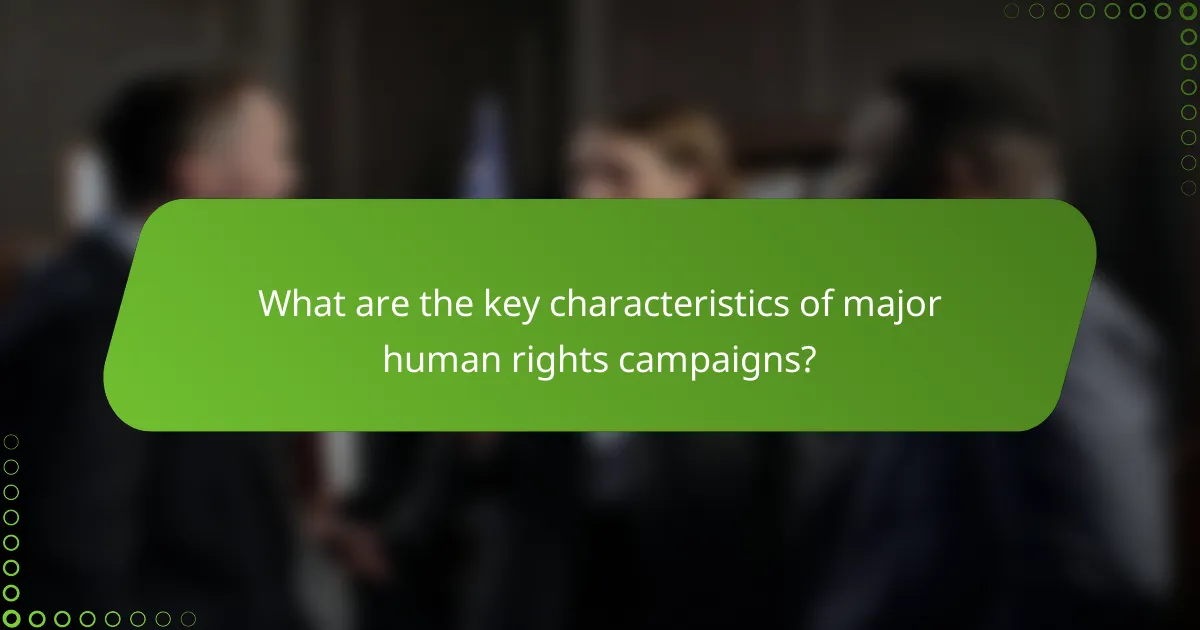
What are the key characteristics of major human rights campaigns?
Major human rights campaigns are characterized by advocacy, mobilization, and awareness-raising. They often target specific injustices, such as discrimination or violence. These campaigns typically involve grassroots organizing and coalition-building. They utilize various media to disseminate information and engage the public. Notable examples include the Civil Rights Movement in the U.S. and the anti-apartheid movement in South Africa. These campaigns often seek legislative changes or policy reforms. They rely on public demonstrations and peaceful protests to gain visibility. Their success is often measured by increased public awareness and changes in laws or social norms.
What common goals do these campaigns share?
Major human rights campaigns share the common goals of promoting equality, justice, and dignity for all individuals. These campaigns aim to eliminate discrimination based on race, gender, sexuality, or socioeconomic status. They often seek to raise awareness about human rights violations and advocate for policy changes. Campaigns also work to empower marginalized communities and ensure their voices are heard. Many focus on providing education and resources to support human rights initiatives. The ultimate goal is to create a more just and equitable society. Historical examples include the Civil Rights Movement and the Women’s Suffrage Movement, which both aimed to secure fundamental rights for oppressed groups.
How do these goals reflect the needs of marginalized groups?
The goals of major human rights campaigns reflect the needs of marginalized groups by addressing systemic inequalities. These campaigns often target issues such as discrimination, access to resources, and social justice. For example, the Civil Rights Movement in the United States focused on ending racial segregation and discrimination against African Americans. This movement highlighted the need for equal rights and opportunities. Similarly, the women’s suffrage movement aimed to secure voting rights for women, addressing gender inequality. These goals are rooted in the specific challenges faced by marginalized communities. Historical data shows that marginalized groups often experience higher rates of poverty, violence, and disenfranchisement. Campaigns that advocate for their rights aim to rectify these disparities. The alignment of campaign goals with the needs of marginalized groups fosters greater social equity and justice.
What strategies are commonly employed in these campaigns?
Common strategies employed in major human rights campaigns include grassroots mobilization, advocacy, and coalition-building. Grassroots mobilization engages local communities to raise awareness and drive action. Advocacy involves lobbying policymakers to enact or change laws that promote human rights. Coalition-building brings together diverse groups to amplify voices and resources. These strategies have been effective in various campaigns, such as the Civil Rights Movement and the anti-apartheid movement. Historical evidence shows that coordinated efforts lead to significant policy changes and societal shifts.
What challenges do human rights campaigns face?
Human rights campaigns face significant challenges such as political opposition, lack of funding, and public apathy. Political opposition often comes from governments that perceive these campaigns as threats to their authority. For instance, authoritarian regimes may suppress dissent and limit freedom of expression. Lack of funding can hinder the reach and effectiveness of campaigns. Many organizations rely on donations and grants, which can be unpredictable. Public apathy poses another challenge, as many individuals may not prioritize human rights issues. This can lead to insufficient grassroots support. Additionally, misinformation and propaganda can distort public perception of human rights efforts. In some cases, activists face personal risks, including harassment or violence. These challenges collectively impede the progress of human rights campaigns.
How do political climates affect the success of these campaigns?
Political climates significantly impact the success of human rights campaigns. A supportive political environment can facilitate advocacy and mobilization. For example, during the civil rights movement in the United States, supportive political leaders helped advance legislation. Conversely, oppressive regimes can stifle dissent and hinder campaigns. In countries with authoritarian governments, activists often face persecution. Historical examples include the Tiananmen Square protests, where a repressive political climate led to violent suppression. Additionally, political climates influence public perception and media coverage, affecting campaign visibility. Campaigns thrive in democratic settings where freedom of expression is protected. Thus, the political landscape is crucial for determining the effectiveness of human rights initiatives.
What role does funding play in sustaining these efforts?
Funding is crucial for sustaining human rights campaigns. It provides necessary resources for advocacy, outreach, and operational activities. Without adequate funding, organizations struggle to maintain their programs and initiatives. For example, the Human Rights Campaign relies on donations to support its various projects. Additionally, funding enables campaigns to mobilize communities and raise awareness effectively. Research indicates that campaigns with stable financial backing are more successful in achieving their goals. Therefore, funding directly impacts the longevity and effectiveness of human rights efforts.
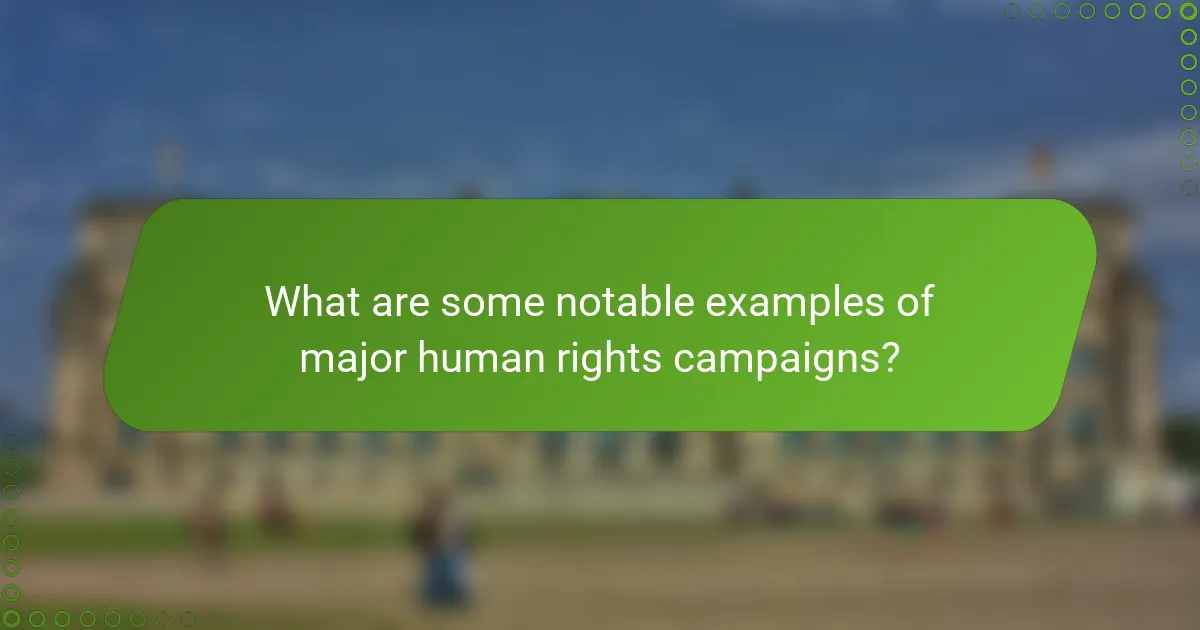
What are some notable examples of major human rights campaigns?
Notable examples of major human rights campaigns include the Civil Rights Movement in the United States. This campaign aimed to end racial segregation and discrimination against African Americans. It spanned the 1950s and 1960s, achieving significant legislative changes like the Civil Rights Act of 1964.
Another example is the Anti-Apartheid Movement in South Africa. This campaign sought to dismantle the apartheid regime, which enforced racial segregation. It gained international support and culminated in the election of Nelson Mandela in 1994.
The Women’s Suffrage Movement is also significant. This campaign fought for women’s right to vote in various countries. In the United States, it was marked by the passage of the 19th Amendment in 1920.
Additionally, the [censured] rights movement has gained prominence. It advocates for equal rights and recognition of [censured] individuals. Landmark events include the Stonewall Riots in 1969, which sparked broader activism.
Lastly, the campaign against child labor has been crucial. Organizations like the International Labour Organization work to eliminate child labor practices worldwide. Their efforts have led to international treaties and improved regulations.
What were the objectives of the Civil Rights Movement in the United States?
The objectives of the Civil Rights Movement in the United States were to end racial segregation and discrimination against African Americans. Activists aimed to secure equal rights under the law. They sought to eliminate barriers to voting for Black citizens. The movement also focused on desegregating public facilities and schools. Another objective was to promote fair employment practices. The Civil Rights Act of 1964 and the Voting Rights Act of 1965 were significant legislative achievements. These laws aimed to ensure civil rights protections and voting access. The movement was marked by peaceful protests, legal challenges, and grassroots organizing.
How did grassroots organizing contribute to the movement’s success?
Grassroots organizing significantly contributed to the movement’s success by mobilizing community members and amplifying their voices. It fostered local engagement and built a strong network of supporters. This approach encouraged collective action, making individuals feel empowered and connected to the cause. Grassroots efforts often led to increased visibility and awareness of the issues at hand. They also facilitated direct communication between activists and the communities affected by injustices. For instance, during the Civil Rights Movement, grassroots organizations like the Student Nonviolent Coordinating Committee (SNCC) played a crucial role in organizing protests and voter registration drives. These initiatives directly influenced legislation and public opinion, showcasing the power of grassroots mobilization in effecting change.
What lasting effects did the Civil Rights Movement have on society?
The Civil Rights Movement significantly transformed American society. It led to the end of legalized racial segregation through landmark legislation. The Civil Rights Act of 1964 outlawed discrimination based on race, color, religion, [censured], or national origin. The Voting Rights Act of 1965 eliminated barriers to voting for African Americans. These laws established a legal framework for future civil rights advocacy. The movement also inspired other social justice movements, including those for women’s rights and [censured] rights. Public awareness of racial inequality increased dramatically. Overall, the Civil Rights Movement laid the groundwork for ongoing discussions about equality and justice in society.
What lessons can be learned from the Anti-Apartheid Movement?
The Anti-Apartheid Movement teaches the importance of solidarity in fighting oppression. It united diverse groups, including international allies, against racial injustice in South Africa. Nonviolent resistance proved effective, exemplified by protests and boycotts. The role of leadership was crucial, with figures like Nelson Mandela inspiring global support. Grassroots mobilization demonstrated the power of community organization. Legal and diplomatic pressure can complement grassroots efforts, as seen in sanctions against the apartheid regime. Lastly, the movement highlighted the need for sustained commitment over time to achieve systemic change.
How did international pressure influence the end of apartheid?
International pressure played a crucial role in ending apartheid in South Africa. Global condemnation of apartheid policies led to economic sanctions against the South African government. Countries imposed trade embargoes, which significantly weakened the economy. The United Nations passed resolutions calling for the end of apartheid and promoting sanctions. Activism by international organizations raised awareness and mobilized public opinion. Notable campaigns included the anti-apartheid movement led by figures like Nelson Mandela and Desmond Tutu. The pressure culminated in negotiations that resulted in the release of Mandela in 1990. These actions collectively contributed to the dismantling of apartheid laws by 1994.
What strategies were most effective in garnering global support?
Effective strategies for garnering global support include mobilizing grassroots movements and leveraging social media. Grassroots movements create local engagement and amplify voices. Social media platforms enable rapid information dissemination and connect diverse audiences. Campaigns like the Civil Rights Movement utilized organized marches and protests to draw attention. The #MeToo movement showcased the power of online platforms to unite individuals globally. Collaborations with influential figures enhance visibility and credibility. International partnerships with NGOs broaden reach and resources. Consistent messaging and storytelling resonate emotionally, fostering empathy and support. These strategies have proven effective in rallying global awareness and action for human rights causes.
How can individuals contribute to ongoing human rights campaigns?
Individuals can contribute to ongoing human rights campaigns by raising awareness and advocating for change. They can share information on social media platforms to inform others about human rights issues. Engaging in community discussions helps to foster understanding and mobilize support. Volunteering with organizations focused on human rights provides direct assistance to campaigns. Financial contributions to these organizations can also enhance their outreach and effectiveness. Participating in peaceful protests and rallies demonstrates solidarity with affected communities. Signing petitions amplifies voices calling for justice and reform. Lastly, educating oneself and others about human rights laws and violations strengthens collective action.
What actions can individuals take to support human rights initiatives?
Individuals can support human rights initiatives by advocating for policy changes. This can involve contacting local representatives to express support for human rights legislation. Individuals can also participate in peaceful protests and demonstrations to raise awareness. Volunteering for organizations that promote human rights is another effective action. Donating to human rights NGOs can provide them with necessary resources. Educating oneself and others about human rights issues is crucial for fostering understanding. Sharing information on social media can help spread awareness and mobilize support. Signing petitions can influence decision-makers to take action on human rights concerns.
How can awareness and education play a role in advocacy?
Awareness and education are crucial for effective advocacy. They empower individuals with knowledge about issues and rights. This informed understanding fosters empathy and drives collective action. For example, the Civil Rights Movement in the U.S. utilized education to highlight racial injustices. Educational programs helped mobilize support and raise awareness of systemic discrimination. Statistics show that informed communities are more likely to engage in advocacy efforts. According to a 2021 study by the Pew Research Center, 70% of individuals engaged in social movements cited education as a key motivator. Thus, awareness and education serve as foundational elements in advocating for change.
The main entity of this article is major human rights campaigns worldwide. The article provides a historical overview of significant movements such as the Civil Rights Movement, the Anti-Apartheid Movement, and the Women’s Rights Movement, highlighting their objectives, evolution, and impact on legislation and societal attitudes. It discusses the challenges these campaigns face, including political opposition and funding issues, while also emphasizing the strategies employed for advocacy and grassroots mobilization. Additionally, it explores how these campaigns have shaped public perception of human rights and the ongoing contributions individuals can make to support these initiatives.
